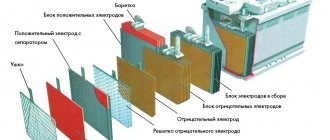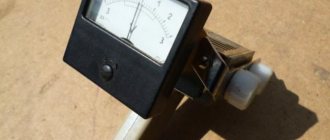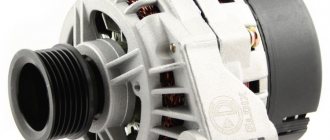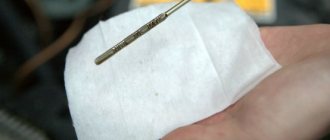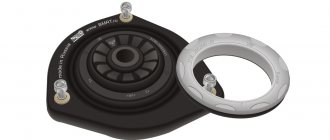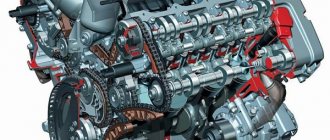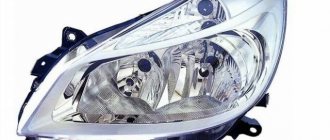Not all car owners know how to maintain a maintenance-free car battery and whether it needs to be done. Problems may also arise at the stage of selecting a power source for the machine’s on-board network. Each type of battery has disadvantages and advantages that need to be considered when purchasing.
Solite maintenance-free car battery design.
How to find out if a battery is serviceable or not
When buying a battery, you should pay attention to the structure of the case. It has a flat surface, is equipped with an indicator and holes for venting gases. If, in addition to the specified parts, there are plugs, after removing which you can see the plates and electrolyte, the battery is serviceable.
The main difference between a maintenance-free battery and a serviced one.
How is it different from serviced batteries?
Actually, they differ in a slightly different plate structure, yet even hybrid batteries sometimes do not reach the characteristics of calcium ones. And an ALMOST sealed case, unattended, with an often locked atmosphere inside. NO TRAFFIC TRAFFIC HERE! And the state of the electrolyte is controlled by the so-called “green eye”
Serviced batteries often have plugs on top for unscrewing and viewing the “cans” inside. That is, you can physically look inside, see the level and condition of the electrolyte ( is it cloudy ), measure its density, inspect the plates for shedding and sulfation .
YES, the structure of the batteries being serviced is different, they have slightly different additives in the plates - for example, in antimony (old versions) only antimony , but it begins to boil when charging already at 12.5 V, so you can’t close the cans, they will simply burst. In hybrids there is a combination of calcium and antimony , calcium + antimony + silver, etc. As a rule, they are also not closed, but stoppers are made for each jar, yet again there is the option of boiling!
I think we figured it out, roughly speaking: no traffic jams - unattended, there are traffic jams - serviced
However, it turns out that with all the advantages of the (“cork-free” option), there are also a large number of disadvantages of these types of batteries.
Maintenance-free battery design
The structure of a maintenance-free battery is not much different from the design of a serviced one. Electrodes and an acid mixture are located inside the housing.
The design also includes the following elements:
- positively and negatively charged lead plates;
- jars - containers into which electrodes are immersed;
- housing with terminals, plugs and indicators.
Design of a maintenance-free car battery.
In gel batteries, standard plates are replaced with spiral electrodes. The lattice elements are impregnated with electrolyte. To prevent electrodes with different charges from touching each other, a separator is included in the design. They participate in chemical reactions accompanied by the release of electrical energy.
It does not interfere with the movement of the acid solution, but prevents short circuiting. The maintenance-free battery case is made of durable material that ensures tightness. The design is insensitive to chemical and mechanical influences.
One of the technologies for manufacturing gel batteries.
Life time
The main criterion for choosing a car battery is its service life. Maintenance-free batteries operate uninterruptedly for 5-6 years.
This is possible subject to the following rules:
- The battery cannot be overcharged or undercharged. It is not recommended to restore the charge using home methods, which can damage the battery.
- Compliance with charging conditions. The supplied voltage should not exceed 14.5 V.
The following factors also affect battery life:
- ambient temperature;
- serviceability of the vehicle's on-board network;
- leakage current;
- character of driving a car.
Popular brands of batteries have longer service lives. Products produced by little-known companies fail quickly. This is due to differences in production technologies.
Battery types
All car batteries, as mentioned earlier, are identical in design and filled with electrolyte, only slightly differing from each other. Each modification is designed to achieve a specific goal to the detriment of other characteristics.
Battery with liquid electrolyte
They are open systems, i.e. gas released during charging may be released into the atmosphere. It has excellent performance characteristics, a long shelf life of up to 15 months, but there is no protection against electrolyte leakage.
Battery Economy
This type of battery is optimal in terms of cost and service life; it uses less lead. It has a reduced engine cold start power and a slightly reduced service life (4 years or 80,000 km). At the same time, a more favorable price, less weight and a low self-discharge current, which does not increase as the battery ages. Can be used in cars with a start-stop system.
Improved battery
They have the abbreviation EFB (Enhanced Flooded Battery) - an enhanced battery with liquid electrolyte. Structurally, they are distinguished by a thicker negative electrode grid, which provides high resistance to corrosion when loaded with high current, as well as the addition of carbon to the active mass of the negative electrode, which leads to improved charging ability.
It has protection against deep discharge and excellent performance characteristics, but there is no protection against electrolyte leakage.
Its design uses a passive mixing element; it reduces electrolyte stratification, i.e. the formation of layers with different concentrations of sulfuric acid, which is concentrated in the lower part of the galvanic cells, which leads to insufficient electrolyte density in the upper part. This occurs when charging and discharging processes are repeated frequently.
Battery AGM
Absorbent Glass Mat is fiberglass with very high absorbency. They are also called recombination and are used on cars with a start-stop system and energy recovery function. In such batteries, the electrolyte is adsorbed by a fiberglass mat. They are a closed system, i.e. all galvanic elements are isolated from the atmosphere by valves.
It is protected against leakage, even if the battery case is damaged, the probability is insignificant and amounts to no more than a few milliliters. They have a long service life, excellent performance and high reliability. But, on the other hand, it has a high cost and higher sensitivity to elevated temperatures.
Gel batteries
There are also batteries with a gel-like electrolyte; it is formed by adding silicic acid to it. They are ordinary lead batteries. They have a very low probability of electrolyte loss, high cyclic resistance and reduced gas formation. Their mass distribution is limited by a number of serious disadvantages, such as: deteriorated starting properties at low temperatures, high cost, intolerance to elevated temperatures and the associated unsuitability for installation in the engine compartment.
Types and characteristics of maintenance-free batteries
There are the following types of maintenance-free batteries:
- Calcium. Adding calcium to the structure of the electrode array allows you to reduce the rate of boiling off of the electrolyte. The driver will not have to constantly measure the level of the acid solution. The main type of such batteries is a closed lead-acid battery.
- Hybrid. Since it is impossible to minimize water loss in the first case, the plates began to be supplied with antimony. The negative electrode contains calcium. Such battery power supplies are marked Hybrid or Ca+. Boiling water is minimal.
- Gel or AGM batteries. The porous material is impregnated with an acid solution. This completely eliminates evaporation. The gel structure made the battery completely maintenance-free.
Designs of maintenance-free batteries.
Do I need to add water or electrolyte?
A new, maintenance-free battery that works properly in your vehicle does not need to be opened or serviced.
If it was subjected to a long recharge, turned over, or its performance dropped sharply - only then you need to think about either purchasing a new battery, or how to disassemble and restore the faulty battery.
When to service your battery:
- If it is visible to the light that there is less electrolyte in one jar.
- The voltage at the terminals is low and charging has no effect.
- capacity noticeably decreased.
- Electrolyte leaked due to damage to the housing.
- Carrying out restoration after battery sulfation.
This is interesting: How long do solar panels last and how to extend this life?
Pros and cons of maintenance-free batteries
The positive qualities of maintenance-free batteries include:
- No need for constant monitoring.
- Easy to use. Although electrolyte replacement is not required, the battery must be charged periodically. This procedure helps to increase service life. For charging, automatic devices are used that do not allow the battery to recharge.
- Can be used in any position. The liquid will not leak from the body and contribute to corrosion of vehicle components.
Battery terminal corrosion.
Despite the large number of advantages, sealed batteries have disadvantages, which include:
- Lack of opportunity to improve performance. If a malfunction occurs, the user will not be able to assess the level and density of the electrolyte or add water.
- High price. A maintenance-free battery costs 1.5-2 times more than a standard one.
- Safe charging only possible when using automatic devices.
Which one to choose, serviced or unserviced
Deciding on the type of battery to purchase can be very difficult. If the car previously had a serviceable battery installed, many car owners prefer not to change their habits. Serviced batteries have the following advantages:
- It is possible to check the electrolyte level and its density.
- If the level is insufficient, you can easily restore the battery’s functionality by adding the required amount of distilled water.
Unfortunately, this type of battery also has many disadvantages:
- Evaporation of water in hot weather and when the battery is overcharged.
- If you roll over on your side or drive too vigorously off-road, an electrolyte spill may occur.
- Higher leakage current, especially if electrolyte was spilled on the upper outer plane, between the terminals, during refueling.
- Additional time costs for preventive inspection and maintenance.
Maintenance-free battery
A maintenance-free battery has the following positive characteristics:
- Set it and forget it;
- No need to add water.
Flaws:
- If the battery fails, it will not be possible to restore its functionality.
- If the electrolyte boils away, it will not be possible to add distilled water without rough mechanical intervention;
- Critical to overcharging and deep discharges.
Attention! If your car has serious electrical problems, a maintenance-free battery will not last long. In this case, it is better to purchase a serviced battery and carefully monitor the quality and level of electrolyte.
If there are no abnormalities in the vehicle’s on-board electrical network, then the most correct decision would be to purchase a maintenance-free device.
Rules for operating maintenance-free batteries
When using a sealed battery, pay particular attention to the tension of the alternator belt and maintain the recommended voltage. Do not allow current leakage when operating electronic devices of the vehicle. The need for recharging occurs under high loads (driving around the city, heating the windows). The decision on the need for additional measures and repairs is made by the user.
Circuit for measuring leakage current.
How to charge
In most cases, the voltage in the on-board network is regulated automatically. The choice of a value of 14.4-14.7 V is justified. As the voltage increases, water begins to decompose, accompanied by increased gas formation. When using a wall charger, overcharging should be avoided. It is recommended to use devices with an automatic control unit.
The charge recovery process is monitored by software. In this case, the supplied voltage is stabilized automatically.
The user only has to connect the contacts of the charger to the current terminals of the battery, observing the polarity. The device is connected to the household electrical network. Charging must take place under positive ambient temperature conditions.
Battery disconnect devices
The battery connection circuit may use squibs or shutdown relays for safety, especially if it is located in the passenger compartment or trunk. The task of these elements is to disconnect the starter and generator wires from the battery at the time of an accident, because Shorting these wires may cause a fire. But the power supply to the on-board network is retained to ensure safety functions (hazard alarms, lighting, etc.)
The best battery brands
The following brands of maintenance-free lead-acid batteries are considered to be of the highest quality:
Mutlu Silver Evolution battery.
- Bosch Silver. German batteries are equipped with silver-plated plates. This ensures stable starting current and long service life. The simplest model of this series will cost 6 thousand rubles. Products marked with the Plus label go on sale. It has a lower rate of electrolyte loss. The battery is equipped with channels that accumulate liquid. This model costs at least 7 thousand rubles.
- Varta Blue Dynamic. The electrodes contain silver, but the battery differs from the previous model in the structure of the plates, which minimizes self-discharge during storage. Such a power source will cost 5 thousand rubles.
- Mutlu Silver Evolution. With a capacity of 55 A/h, the battery produces a current of 420 A. You can buy it for 4-5 thousand rubles.
- Medalist. The power supply operates uninterruptedly for up to 7 years. The battery is resistant to overcharging.
The best gel voltage supply cell is Bosch 5951. The battery quickly restores capacity even after a long period of being in a discharged state. The disadvantage is the lack of a charge indicator on the case. The Kainar Bars Premium gel battery, produced in Kazakhstan, has the lowest cost. The most expensive model of this type is Tudor AGM. It produces a starting current of 680 A with a capacity of 60 A/h.
Main characteristics of the battery
Energy Conversion Ratio
The energy supplied to the battery when the battery is charging is greater than the energy it gives out during discharge. The excess of the “charge” energy to the “discharge” energy is based on the need to cover the costs of electrical and chemical processes.
To fully charge, you need 105–110% of the energy previously consumed. Thus, the conversion factor will be between 1.05 and 1.10.
Capacity
The capacity of the battery is proportional to the amount of electric current supplied to it. The unit of capacity is ampere hours (Ah).
Capacity indicators are affected by discharge current and temperature. It tends to decrease with increasing discharge current and decreasing temperature, in particular at values less than 0 degrees.
Rated voltage
The standard voltage of each battery element corresponds to 2 V, and the voltage of the entire battery chain is equal to the number of galvanic cells. The machine's battery consists of 6 batteries, which corresponds to a nominal capacity of 12 V.
Cold crank current
This indicator characterizes the starting capabilities of the battery when operating in low temperature conditions. This parameter is measured at –18 °C. The voltage of a fully charged battery does not drop below the specified value for a certain amount of time. The current level affects the starting of the car engine, since the higher the current value in cold cranking, the easier the engine will be to start in the winter season.
Voltage
The voltage, the value of which is measured between the two pole terminals of the battery - the voltage at the terminals.
Gas release voltage is a parameter above which water is formed in the battery housing. This occurs when the voltage of the entire battery is exceeded, the maximum permissible value being 14.4 V.
The decomposition of water produces hydrogen and oxygen, which combine to form a gas. Warning - this is explosive!
Idle voltage or open circuit voltage is a state when there is no load at the battery outputs. Charge and discharge cycles change the open circuit voltage. When the amount of sulfuric acid between the galvanic cells is restored, the open circuit voltage comes to its final value - the resting voltage.
